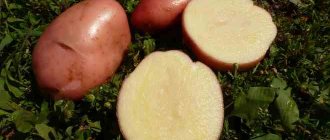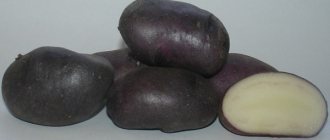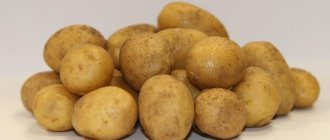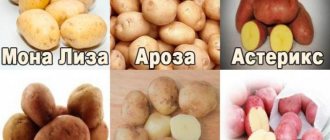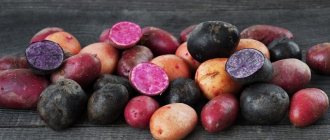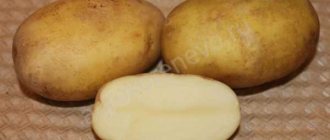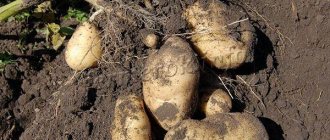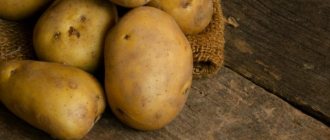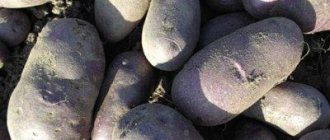Vegetable growing » Potatoes
0
2007
Article rating
Kira Stoletova
Among the range of potatoes that are presented on the modern market, Ramos potatoes have recently become very popular. It gained its popularity not only due to its good taste, but also due to the simple rules of care that are followed at the stage of planting and growing such a plant.
Description of Ramos potatoes
History of the origin of the Ramos potato variety
Potato variety "Ramos" is the result of the successful work of breeders from Germany. Patent holder KWS POTATO BV
It was included in the State Register of Russia in 2006.
Recommended regions for cultivation are Central and Central Black Earth.
The table shows data on the growing season of different potato varieties:
| Name | Variety | Days |
| Nikulinsky | Late ripening | 115-120 |
| Cardinal | Late ripening | 110-120 |
| Rocco | Late ripening | 100-115 |
| Kiwi | Late ripening | 120-130 |
| Ivan da Marya | Late ripening | 115-130 |
| Slav | Late ripening | From 125 to 140 |
| Borovichok | Early ripening | 70-90 |
| Elmundo | Early ripening | 70-80 |
| Felox | Early ripening | From 65 to 70 |
| Bellarosa | Early ripening | From 50 to 70 |
| Natasha | Early ripening | From 70 to 80 |
| Karatop | Extra early | From 60 to 65 |
| Riviera | Extra early | From 40 to 80 |
| Zhukovsky early | Extra early | 60 to 70 |
| Farmer | Extra early | From 50 to 60 |
| Minerva | Extra early | 45-50 |
| Crane | Mid-late | From 100 to 120 |
| Sorcerer | Mid-late | 80-90 |
| Mozart | Mid-late | From 100 to 180 |
| Ramona | Mid-late | From 80 to 100 |
| Limonka or Picasso | Mid-late | 120-130 |
| Yanka | Mid-early | 90-100 |
| Giant | Mid-early | From 80 to 100 |
| Tuscany | Mid-early | 70-90 |
| Purple Haze | Mid-early | 90-100 |
| Openwork | Mid-early | 75-85 |
Unpretentious to weather conditions, mid-season potato variety "Ramos"
Ramos is a mid-season potato variety officially included in the state register. It is cultivated on farmland and summer cottages. With the right approach to cultivation, you can reap a generous harvest.
Below you will find a description of the variety, recommendations for growing it, photos and reviews of Ramos potatoes.
Description of the variety
Ramos is a table variety. It has high taste qualities. It has proven itself well in the cooking process - it does not boil over, which is why it is suitable for any dishes.
Often used to prepare French fries in catering establishments. Ramos can be stored for a long time, so owners of retail outlets readily take it for sale.
Origin and development
The Ramos variety was developed by German breeders. Due to its unpretentiousness to external conditions and resistance to many diseases, it began to be cultivated on an industrial scale.
Consumers appreciated the taste of potatoes, and their popularity began to grow outside of Germany. It was included in the register of the Russian Federation in 2006.
Chemical composition, trace elements and vitamins
starch varies between 13-16%. Ramos potatoes are also rich in the following beneficial substances:
- vitamins A, B, C, E;
- potassium;
- phosphorus;
- calcium
To get the maximum nutritional content, it is recommended to boil potatoes with their skins on.
Ripening time and yield
Tubers are ready for consumption 70-80 days after germination, young potatoes can be dug after 30-45 days. In regions with cool summers, the interval between germination and ripening reaches 100-110 days. In the southern regions, two crops can be harvested.
The average yield is 370 centners per hectare; under favorable conditions, the figure exceeds 400 centners. In bad years, the yield drops to 200 centners per hectare. 8-13 tubers come out of the bush.
Disease resistance
Ramos is resistant to potato golden nematode and potato blight. In general, with proper care, the crop is rarely infected with the exception of late blight.
Characteristics of tubers and description of appearance
The tubers have an oblong shape. The peel is dense, slightly rough, and rich yellow in color. The eyes are small, located slightly in the recess. The flesh is yellow when cut. The average weight of a potato is 100-130 g.
The bush is straight, tall compared to other varieties. The leaves are dark green and large. During the flowering period, the bushes are dotted with small white flowers that form a corolla.
Growing regions
The Ramos variety is suitable for cultivation in central Russia. But the southern regions, where summer weather lasts 4-5 months, are considered ideal for its cultivation.
Advantages and disadvantages of the variety
Ramos potatoes are popular among farmers and gardeners. It is valued for its excellent taste, high shelf life, and ease of care.
Advantages of the variety:
- High yield, the ability to harvest two crops in one season.
- Early maturation.
- Keeping quality 97%.
- Mostly large commercial tubers - 90-98%.
- Resistant to moisture deficiency.
- Simple agricultural techniques for growing.
- Good taste.
The disadvantages of the variety include a high percentage of late blight development. If the disease is not detected in time and measures are not taken, a significant part of the crop will die.
Difference from other varieties
Ramos potatoes are officially included in the state register and are recommended by agronomists for cultivation in the North-Western, Central, Central Black Earth, North Caucasus, Middle Volga and Ural regions.
The main difference from other varieties is the ability to get two harvests per season.
Features of planting and growing
When growing Ramos potatoes, the same agricultural techniques are used as for other varieties. It does not require special care; even a novice gardener has a chance to get a high yield.
Preparing for landing
It is recommended to prepare planting material at harvest. You need to start not from the size of the tubers, but from the bushes. You need to choose the healthiest bushes with bright green tops, untouched by diseases and pests.
It is also advisable to prepare the future area for potatoes in the fall. It is necessary to free it from weeds and tops from harvested crops. Then dig up and apply nitrogen-potassium fertilizers.
Planting material is removed from storage two weeks before the intended planting in the ground. This promotes faster germination. Additionally, it is recommended to treat with a growth stimulator and a disinfectant composition, for example, the powerful chemical “Prestige”.
Soil requirements
Ramos potatoes are generally not picky about soil type. Ideally, fertile black soils are suitable, but planting in other types of soil is not critical. To increase yields, it is recommended to plant potatoes where legumes or grains grew last year. Cabbage and onions are considered good neighbors.
Important! You cannot plant potatoes in beds where tomatoes and peppers grew last season. Cultures are vulnerable to the same diseases. If infectious agents remain in the soil, they will spread to the potatoes, which will lead to the death of the crop.
Dates, scheme and rules of planting
The recommended time for planting tubers in the ground is the beginning of May, when the air temperature exceeds +18ºС. The soil temperature should not be less than +10…+13ºС.
The optimal distance between holes is 30-35 cm, between beds - 60 cm. Tubers are buried in the ground no more than 10 cm. Otherwise, they will take a long time to germinate, and as a result, will take a long time to ripen.
Reference. The greater the distance between the holes, the larger the tubers will be.
Features of cultivation
To grow, a basic understanding of agricultural technology is sufficient. As soon as the sprouts emerge from the ground, it is necessary to begin care. When potatoes fade, it is recommended to pick off the flowers. Then the plant will direct all its energy to the growth and development of tubers.
All care consists of irrigation, fertilizing and pest control. Events are held at certain stages of cultural development.
Watering mode
The Ramos variety does not require regular watering. At the stage of sprouting, you can water the beds 2-3 times. If May and June are rainy, there is no need for the procedure.
You can determine the moisture deficit by looking at the bottom leaves - if they are dry, watering will not hurt. In particularly hot regions, it is worth equipping a drip irrigation system.
Top dressing
Ramos takes root in any soil, but requires spraying and root feeding.
Fertilizer application scheme:
- First feeding: mix 0.5 liters of humus and 15 g of saltpeter in 10 liters of water. Apply 1 liter per bush after watering.
- Second feeding : stir a glass of wood ash, 15 g of potassium phosphate and superphosphate in 10 liters of water. Pour 0.5 liters under each bush.
- 2-3 weeks before harvest, it is recommended to spray - 2 tbsp per 10 liters of water. spoons of superphosphate. Each bush needs 0.5 liters of solution.
The first and second root feedings are carried out until the end of June. Afterwards, the tubers will have already formed, and excess fertilizer will lead to a decrease in the taste and beneficial properties of potatoes.
Weeding and hilling
Weeds must be removed at all stages of cultivation. After flowering, you can only pull out large grass, which does not allow tubers to develop.
Attention! Ramos does not respond well to weed control chemicals. It is not recommended to use them after germination.
Hilling up is an equally important event. The first time you need to hill up the beds is after the sprouts appear. This is necessary to aerate the soil that was trampled during planting. Hilling is carried out several times, but only until the potatoes bloom.
Disease and pest control
Despite the variety's resistance to most diseases, potatoes are susceptible to pest invasion. In the southern regions, the crop is attacked by aphids, Colorado potato beetles, mole crickets, wireworms, spider mites, and cicadas.
For the prevention and control of insects and diseases, you can use the following drugs:
- "Bikol" destroys the larvae of the Colorado potato beetle.
- “Killer”, “Destroy” - for fighting adult beetles.
- “Taboo” and “Aktara” cope well with wireworms, aphids, and mole crickets.
- "Maxim" destroys pathogens of scab, fusarium, and rhizoctonia. Also used for black and gray rot.
- "Fitosporin-M" - prevention and treatment of late blight.
- "Rubit Discor" is a powerful drug for the treatment of scab, blackleg, and powdery mildew.
Difficulties in growing
In addition to the high risk of late blight infection, the variety has one feature - dependence on temperature. Ramos loves it when the air warms up to +18…+22ºС. If the temperature drops or does not exceed +5ºС, the growth and development of the crop is suspended. There is also a risk of losing your harvest if you have a rainy summer.
Harvest and storage
Potatoes are dug up at the moment of technical maturity. In order not to miss the deadline, you need to count down the time from the day of planting. Young tubers are ready for consumption much earlier, usually a month after germination. But they need to be collected in quantities necessary for cooking - they do not last long.
How and when to collect
7-10 days before harvesting, you need to cut off the tops so that the tubers grow. It is better to dig potatoes on a clear, dry day. After harvesting, you need to leave the tubers under a canopy or in the beds to dry.
Attention! Potatoes must be dug strictly on time; it is not recommended to delay harvesting even for a week. The variety is vulnerable to late blight, which affects even ripe tubers.
Storage features and keeping quality of the variety
You can store potatoes in a barn, cellar, or refrigerator. Subject to storage conditions, shelf life is 97%. The optimal place is a dry, dark room in which the temperature does not exceed +4…+5ºС. Tubers in a warm place are fraught with wrinkling and early germination.
Advice from experienced gardeners and reviews about the Ramos variety
Agricultural workers value Ramos potatoes for their unpretentiousness. Summer residents grow it for themselves primarily because of its excellent taste and high shelf life. To grow on a plot, it is not necessary to understand all the intricacies of agriculture.
Beginning gardeners should listen to the advice of experienced farmers:
- Choose a sunny place for planting.
- Ramos does not like excess moisture. It is better to choose dry places on a hill.
- When watering, make sure that water does not get on the tops. Otherwise, the risk of developing late blight increases.
- It is better to fight weeds without using chemicals.
Gardeners are also ready to share reviews about the variety.
Ivan, Vologda: “Young tubers have an interesting feature - when treated with a growth stimulant, they quickly germinate. If the climatic conditions of the region allow, you can harvest twice.”
Veronica, Tula: “The variety is really productive. An average of 15 tubers came out of the bush, all almost the same size, even and neat. Excellent taste. The potatoes performed well during the preparation of all dishes.”
Natalya, Tver: “I tried to raise Ramos in the country. The variety is truly unpretentious and requires minimal care. There were no problems with diseases during the growing process. The tubers have a marketable appearance. Potatoes keep well.”
Conclusion
Ramos is a relatively unpretentious mid-season potato variety. It is successfully cultivated by experienced farmers on an industrial scale and by summer residents for their own needs. Ideal for hot, dry areas. But gardeners from regions with rainy summers are better off choosing another variety - Ramos does not tolerate excess moisture.
Ramos seed potatoes. Brief overview, description of characteristics, where to buy Ramos potatoes
Source: https://agronom.expert/posadka/ogorod/paslenovye/kartofel/ramos.html
Description of the variety
Roots:
- Tubers are oval-elongated;
- With a thick, rough yellow skin;
- Small eyes, slightly recessed;
- The flesh is deep yellow when cut;
- Starch content 13-16%;
- Average weight from 100 grams and above;
- The yield of one bush is from 8 to 12 tubers.
Planting potatoes:
Bushes:
- The plant is erect, stemmed, tall;
- Dark green leaves of a typical potato shape, intermediate type, large in size, wrinkled structure, without pubescence, with slightly wavy edges;
- Many small flowers;
- White corolla.
Characteristics of the variety
Alena was bred in Holland at the end of the last century. Literally a few years later it was included in the national register. It is believed that it is best to grow it in northern countries, where climatic conditions are always cold.
It is recommended to grow it not only on agricultural land, but for personal use. Quite often it is grown in industrial enterprises. This is due to the fact that these potatoes tolerate long-term storage well and can be transported over long distances. Due to the fact that its tubers have an ideal, even shape, it makes excellent semi-finished products. Also, it is very often grown for sale.
The description and characteristics of the plant deserve attention. Alena ripens faster than other early varieties. Its tubers form and ripen in a month and a half. It is believed that full ripening occurs 50 days after planting. Productivity is high. From 1 hectare of vegetable garden it is possible to collect up to 300 kg of finished products.
It is believed that the harvest will be at a high level if the soil is rich in useful microelements. Also, if you properly care for this species and feed the soil on time, you can increase the amount of harvest by 2-2.5 times. If you plant seed material in June, then in July you can already dig a small amount of potatoes for your own consumption. But mass cleaning should be carried out in August.
Appearance
The bush does not grow tall. Its tops can spread, but not over long distances. The leaves on the tops are small in size and have minimal waviness at the edges. The corollas are presented from a small number of white flowers.
The root system is striking in its development. You can collect up to 20 root vegetables from one bush. Due to the small quantity of non-commercial products, it sells quickly. The variety is not susceptible to diseases, so you don’t have to worry about diseases and pests. Alena potatoes do not degenerate, so you can collect seed material yourself from the previous harvest.
Description of the fruit
Ripe tubers are quite large. The weight of each tuber can reach 150-200 g. The shape resembles an oval, and is always smooth, without flaws. You can find fruits that will have an oblong shape. All tubers have the same weight and their shape is similar to each other, which is why they are so ideal for sale.
The peel is presented in light yellow tones, and is very thin in structure. Its color is uniform throughout the potato. You can see eyes, but they are very small, almost invisible. If you cut the fruit, you can see that the flesh has a cream or yellow tint. The amount of starch is not bad, and is about 14%. Alena contains a large amount of vitamins, minerals, and protein, so it can be used not only for making purees or soups. This is ideal for baking or making French fries.
Advantages and disadvantages
Potatoes of the Ramos variety have many advantages:
- Fast and good development;
- High productivity;
- High marketability of root crops;
- A small percentage of small tubers;
- Excellent taste characteristics;
- Resistant to dry periods;
- Undemanding to soil type;
- Good immunity to most diseases;
- Resistant to mechanical damage;
- Capable of long-term storage.
Disadvantages include susceptibility to late blight of tubers and tops.
Agricultural technology
Potatoes must be planted in a sunny and unshaded area. Tubers intended for planting must be removed from storage in advance: approximately two weeks before the start of planting. Potatoes in the fresh air will germinate better and the quality of germination and development of the plant as a whole will subsequently increase.
Landing
Potato Ramona
Despite the fact that a significant characteristic for a plant such as the Ramos potato variety is its unpretentiousness to the soil, it is strongly recommended to prepare the latter. Moreover, this should be done in the fall: after harvesting, the soil is cleared of weeds, dug up and fertilized. As a rule, potash or nitrogen fertilizers are applied. In the spring, before sowing potatoes, the soil should be dug up again.
Important! Potatoes should never be planted in an area where tomatoes were previously grown. This is due to the fact that both plants are prone to the same diseases, which can easily be contracted from each other. The best neighbors for any potato variety are cabbage, legumes and onions.
The Ramos potato variety is planted in the soil after its temperature has warmed up to at least +10 degrees. At lower temperatures, the tubers may simply freeze. The depth of the holes dug for planting material can vary from 10 to 15 cm. The distance between them must be at least 20 cm.
Potatoes should be planted in sufficiently warm soil.
Important! The greater the distance between plants, the larger the tubers will eventually grow at the end of the season.
In most Russian regions, Ramos potatoes are planted already in May, when the risk of soil freezing is minimized.
On a note. When choosing a specific place for planting, you should avoid excessively wet areas. Ideally, the soil should be fairly dry.
After the first shoots appear, it is very important to provide the plant with proper care. This growing parameter is of particular importance in terms of obtaining a decent harvest.
Potato care
High-quality crop care begins with loosening the soil trampled during planting. This procedure will delay the appearance of weeds. In addition, loosening improves soil aeration, more air enters it, and the plant develops faster.
It is equally important to be able to protect the first shoots from frost, which can happen in some areas even in summer. For this purpose, the first shoots are covered with loosened soil. The layer of the latter should be from 3 to 5 cm. If nothing like this is done, the plants are likely to die, and the mother tubers will not be able to produce new shoots a little later. The yield will eventually decrease, quite significantly.
Another feature of potato care is the mandatory hilling of the crop. It is done to divert the sprouts in different directions. As a result, the bush grows more spreading, and a larger number of tubers are formed on young shoots.
In addition, another useful property of hilling is that it reliably protects young bushes from damage by the Colorado potato beetle that has managed to safely overwinter. Hilling should be done several times during one season. But with the beginning of flowering of Ramos potatoes, hilling is stopped. At this time, mulching is most effective for weed control. Sawdust, pine needles or humus can be used as mulch.
Unfortunately, it is completely impossible to protect the plant from all dangers without the use of chemicals. In this case, it is important to adhere to the principle of the golden mean and try to use the least dangerous fertilizers in reasonable quantities. In particular, about a month before harvesting, potatoes should be sprayed with superphosphate in order to increase the flavor richness of the tubers and their keeping quality.
During dry seasons, potatoes require watering. But under no circumstances should you moisten the plant immediately after planting.
This can disrupt the development of the root system, which, in turn, will negatively affect the harvest. The first watering should be done no earlier than the seedlings appear. As the bush grows, its need for moisture will increase. But this does not mean that the culture should be flooded. As a rule, dry lower leaves indicate a lack of water.
The most suitable temperature range for tuber formation is 18-22 degrees. If the average temperature stays above +25 degrees for a long time, potato growth slows down somewhat, and at +30 it stops altogether. Lowering the temperature leads to similar consequences. In general, Ramos potatoes are high-yielding varieties.
The Ramos potato harvest pleases us with its abundance
Ramos potatoes require the greatest amount of water during the flowering period. Potatoes should be watered with water left in the sun early in the morning or after sunset.
It is most convenient to select future planting material during the harvesting process. In this case, the decisive role should be played not so much by tubers as by plant shoots. The specimens whose tops have the healthiest structure are optimally suited. In order not to make a mistake in the end with the choice, it is strongly recommended to somehow mark the bushes, the tubers of which will later be used for planting. The size of the tuber does not matter. The shoots from them will actually be no worse.
Important! Potatoes should be watered in such a way that water does not get on the foliage. Otherwise, the risk of plant damage by a disease such as late blight of green mass will increase significantly.
Generally speaking, the plant is quite resistant to most pests and diseases.
Correct fit
When planting, you must adhere to certain rules:
- Two weeks before planting, the seed material is taken out of storage into a lighted room so that the tubers germinate;
- Despite the undemanding nature of the variety regarding soil type, it is necessary to apply fertilizers;
- It is not recommended to plant potatoes after tomatoes, or next to tomatoes, since they have common diseases and pests. It is better to plant potatoes after legumes and grains, next to cabbage and onions;
- As soon as the soil warms up to +13 ºС at a depth of 10 cm, begin planting the seed. The distance between planting holes should be at least 20 cm, since the Ramos variety is characterized by the intensive development of many root crops;
REFERENCE: In the fall, the site must be dug up, weeds must be removed and fertilizers with potassium and nitrogen must be applied. In the spring, re-digging is carried out.
- Planting is carried out in early May. The air temperature should not be lower than +18 ºС, since the variety does not like high temperatures. For planting, choose dry areas or hills.
Growing Ramos Potatoes
Potatoes of this variety must be removed from storage 2 weeks earlier before being planted in a clarified area. Such greening will subsequently have a beneficial effect on the development and good germination of the plant.
Despite the fact that this type of potato is not at all sensitive to the type of soil in which it is planted, in any case it is necessary to take care of the timely application of fertilizers. It is advisable to prepare for such a process in advance, namely from the very beginning of autumn. To do this, after the potatoes are dug up, the soil must be cleared of weeds and dug up. After this, it is advisable to add nitrogen and potassium fertilizers to the soil. In the spring, just before planting, the land must be dug up again.
If you decide to plant a plant in the place where tomatoes grew last year, then it is better to abandon such an idea. In addition, it is not advisable for potatoes to grow near tomatoes. This is due to the fact that some tomato diseases can spread to the plant. Onions or cabbage can be considered the most favorable neighbors. As for the soil in which it is preferable to plant potatoes, it is desirable that grains or legumes grow on this plot of land before that.
Planting in the soil
Potatoes of this type, first of all, should be planted in the ground only when the soil temperature warms up to 10-13 degrees Celsius. The depth of the holes into which the planting material is placed should be about 10-15 cm. As for the distance between the bushes, it should be no less than 20-25 cm. This distance can be increased further, since potatoes of this type have large tubers that are capable of increasing with growth. Therefore, free space will not be wasted.
The most favorable period for planting mid-early species can be considered the beginning of May. It is during this period that the soil temperature should be most favorable. When choosing a location, pay attention to fairly dry areas of land, as this species does not like excessive humidity. Do not forget that as soon as the very first shoots appear on the ground, it is strictly forbidden to use products aimed at eliminating weeds.
Care
Proper care includes the following:
- To improve oxygen access to the root system, regularly loosen the soil. The procedure is also necessary after precipitation and watering to avoid the formation of a crust on the surface of the soil;
- Hill up twice during the season;
- Timely weeding will help get rid of weeds;
- Watering is not necessary;
- Carrying out root feeding and spraying with fertilizers.
REFERENCE: To get a good harvest, flowers are plucked from the bushes so that all the growth goes into root crops.
Growing and care
During hot periods, water the potatoes generously in the evenings with warm water. Watering is needed 3-5 per season.
The wet soil is loosened and the bushes are hilled up. The first time the hilling procedure is carried out a week after germination, the second - two to three weeks after the first.
Fertilizing is applied three times:
- A week after the sprouts appear, prepare a solution of several tablespoons of chicken manure in a bucket of water. Dosage: 400 ml for each plant.
- With the appearance of buds, add a solution of 20 g of potassium sulfate and the same amount of superphosphate to a bucket of water.
- After flowering, prepare a weak solution of superphosphate. You can add a little mullein and water the plants at the root.
Diseases and pests
Ramos potatoes have good immunity against potato canker, golden cyst nematode, and a number of viral diseases. Carrying out preventive spraying using microbiological preparations will protect potato plantings from pests and diseases.
We invite you to familiarize yourself with potato varieties that have different ripening periods:
| Late ripening | Early ripening | Very early | Mid-late | Mid-early |
| Nikulinsky | Borovichok | Forty days | Crane | Yanka |
| Cardinal | Elmundo | Karatop | Sorcerer | Giant |
| Rocco | Felox | Riviera | Mozart | Tuscany |
| Kiwi | Bellarosa | Zhukovsky early | Grenada | Purple Haze |
| Ivan da Marya | Natasha | Farmer | Melody | Openwork |
| Picasso | Ariel | Minerva | Margarita | Santana |
| Asterix | Queen Anne | Veneta | Ramona | Desiree |
| Slav | Arosa | Kiranda | Dolphin | Lady Claire |
Ramos potatoes - variety description, photos, reviews, planting and care
Among the range of potatoes that are presented on the modern market, Ramos potatoes have recently become very popular. It gained its popularity not only due to its good taste, but also due to the simple rules of care that are followed at the stage of planting and growing such a plant.
Description of Ramos potatoes
German quality in our beds: Ramos potatoes - description of the variety with detailed characteristics and abundant photos
Another variety of yellow potatoes produced by German producers is popular among Russian gardeners - “Ramos”.
- Description of the variety
- Description of the root vegetable
- Description of the escape
- Climatic growing zones
- Productivity
- Purpose
- Taste qualities
- Advantages and disadvantages
- Country of origin, year of registration
- Features of cultivation
- Storage Features
- Diseases and pests
- Photobank
- Conclusion
Source: https://sovhozik.ru/ovoshhi/kartofel/kartofel-ramos-opisanie-sorta-foto-otzyvy-posadka-i-uhod
Reviews about the variety
Both experienced potato growers and novice gardeners and summer residents speak positively about Ramos potatoes. The tubers have a pleasant and rich potato taste. Thanks to their dense pulp, potatoes do not get soggy when cooked. Growing in different types of soil does not affect the taste characteristics of potatoes. The harvested crop is stored for a long time even at low temperatures above zero. Root crops are resistant to mechanical damage and tolerate long-term transportation.
Potato variety "Ramos" is an excellent representative of German selection. An excellent option for both experienced and beginner gardeners. The Ramos variety has become widespread throughout Russia. Potatoes are grown on personal plots and on farms.
Features of agricultural technology
Like most Dutch varieties, it is prone to degeneration, so the seed material is regularly renewed.
When the supply of planting tubers is independently renewed during flowering, the strongest, most abundantly flowering bushes are noticed. The consumption of seed tubers with a fraction of 35-55 mm for planting per hectare is 50,000 pieces.
Before planting, the tubers are germinated, spread out in a bright, warm place for 3-4 weeks. All tubers should be evenly illuminated for at least 8 hours a day. The room maintains an optimal humidity of 85-90%.
Large tubers are cut into pieces with a sharp knife dipped in a strong solution of potassium permanganate the day before planting. Planting material with sprouts of 0.5-1 cm is selected.
Planting is done in soil heated to +15-20°C according to a 60x35 cm pattern. Planting tubers are placed with the sprouts up, the slices with the cut down.
During cultivation, crop rotation is observed. On large areas, the yield increases after perennial and annual grasses, grains, legumes, winter crops, flax, rapeseed, phacelia, and rapeseed.
Good green manures for this potato variety in the garden include white mustard, peas, zucchini, and pumpkin. Mustard will prevent the soil from being blown out and washed away and will repel wireworms. Legumes will provide Ramona's favorite nitrogen.
To improve the agrophysical properties of heavy, clayey soils, river sand and wood ash are added during autumn digging. When digging again in spring, add amophoska or ammonium nitrate, urea (10 g/m²).
If the groundwater is close, it is better to plant Ramona in ridges. This will increase the access of oxygen to the root system and reduce the incidence of fungal diseases on the tubers.
Agronomists recommend orienting planting ridges from east to west. This will give the potatoes more sunlight.
On loamy, heavy soils, tubers are planted in holes 6-8 cm deep. Planting depth in sandy loam and sandy soils is 8-10 cm. To prevent tubers from drying out in areas with an arid climate, the depth is increased to 12-15 cm.
"Ramona" is often affected by potato nematode. To prevent the disease and protect against wireworm larvae and May beetles, experienced potato growers recommend placing a handful of garlic and onion peels in each hole.
Over the entire growing season, Ramona requires up to five loosenings. When a soil crust forms, before germination appears, the soil is carefully hoeed. Hill up 2-3 times over the summer - manually or using a walk-behind tractor.
Potatoes of the Ramona variety form tubers even with low soil moisture. During drought, one-time watering between rows for 7-10 days is sufficient. Mulching will help protect plantings from weeds.
To improve the quality of products during the flowering period and ripening of tubers, plants are supported with nitrogen or organic fertilizers. When spraying bushes during bud setting with 0.05% aqueous solutions of copper sulfate, zinc sulphate, boric acid, the yield increases by 8-10%.
Read more about how to feed potatoes, what fertilizers are best, when and how to apply them, and how to do it correctly when planting.
A week before harvesting, the tops are mowed. Dig up potatoes in dry weather. The tubers are dried and sorted before storing.
Read useful and interesting articles about a variety of ways to grow potatoes: Dutch technologies and caring for early varieties, how to get a good harvest without weeding and hilling. And also what is the difference between these methods: under straw, in barrels, in bags, in boxes.
Despite average yields, “Ramona” has taken root in domestic fields due to its unpretentiousness, drought resistance, good resistance to diseases and the Colorado potato beetle, and excellent taste.
Harvest and storage
Potatoes are dug up at the moment of technical maturity. In order not to miss the deadline, you need to count down the time from the day of planting. Young tubers are ready for consumption much earlier, usually a month after germination. But they need to be collected in quantities necessary for cooking - they do not last long.
How and when to collect
7-10 days before harvesting, you need to cut off the tops so that the tubers grow. It is better to dig potatoes on a clear, dry day. After harvesting, you need to leave the tubers under a canopy or in the beds to dry.
Attention! Potatoes must be dug strictly on time; it is not recommended to delay harvesting even for a week. The variety is vulnerable to late blight, which affects even ripe tubers.
Storage features and keeping quality of the variety
You can store potatoes in a barn, cellar, or refrigerator. Subject to storage conditions, shelf life is 97%. The optimal place is a dry, dark room in which the temperature does not exceed +4…+5ºС. Keeping tubers in a warm place is fraught with wrinkling and early germination.
Features of planting and growing
When growing Ramos potatoes, the same agricultural techniques are used as for other varieties. It does not require special care; even a novice gardener has a chance to get a high yield.
Preparing for landing
It is recommended to prepare planting material at harvest. You need to start not from the size of the tubers, but from the bushes. You need to choose the healthiest bushes with bright green tops, untouched by diseases and pests.
It is also advisable to prepare the future area for potatoes in the fall. It is necessary to free it from weeds and tops from harvested crops. Then dig up and apply nitrogen-potassium fertilizers.
Planting material is removed from storage two weeks before the intended planting in the ground. This promotes faster germination. Additionally, it is recommended to treat with a growth stimulator and a disinfectant composition, for example, the powerful chemical “Prestige”.
Soil requirements
Ramos potatoes are generally not picky about soil type. Ideally, fertile black soils are suitable, but planting in other types of soil is not critical. To increase yields, it is recommended to plant potatoes where legumes or grains grew last year. Cabbage and onions are considered good neighbors.
Important! You cannot plant potatoes in beds where tomatoes and peppers grew last season. Cultures are vulnerable to the same diseases. If infectious agents remain in the soil, they will spread to the potatoes, which will lead to the death of the crop.
Dates, scheme and rules of planting
The recommended time for planting tubers in the ground is the beginning of May, when the air temperature exceeds +18ºС. The soil temperature should not be less than +10…+13ºС.
The optimal distance between holes is 30-35 cm, between beds - 60 cm. Tubers are buried in the ground no more than 10 cm. Otherwise, they will take a long time to germinate, and as a result, will take a long time to ripen.
Reference. The greater the distance between the holes, the larger the tubers will be.
Features of cultivation
To grow, a basic understanding of agricultural technology is sufficient. As soon as the sprouts emerge from the ground, it is necessary to begin care. When potatoes fade, it is recommended to pick off the flowers. Then the plant will direct all its energy to the growth and development of tubers.
All care consists of irrigation, fertilizing and pest control. Events are held at certain stages of cultural development.
Watering mode
The Ramos variety does not require regular watering. At the stage of sprouting, you can water the beds 2-3 times. If May and June are rainy, there is no need for the procedure.
You can determine the moisture deficit by looking at the bottom leaves - if they are dry, watering will not hurt. In particularly hot regions, it is worth equipping a drip irrigation system.
Top dressing
Ramos takes root in any soil, but requires spraying and root feeding.
Fertilizer application scheme:
- First feeding: mix 0.5 liters of humus and 15 g of saltpeter in 10 liters of water. Apply 1 liter per bush after watering.
- Second feeding : stir a glass of wood ash, 15 g of potassium phosphate and superphosphate in 10 liters of water. Pour 0.5 liters under each bush.
- 2-3 weeks before harvest, it is recommended to spray - 2 tbsp per 10 liters of water. spoons of superphosphate. Each bush needs 0.5 liters of solution.
The first and second root feedings are carried out until the end of June. Afterwards, the tubers will have already formed, and excess fertilizer will lead to a decrease in the taste and beneficial properties of potatoes.
Weeding and hilling
Weeds must be removed at all stages of cultivation. After flowering, you can only pull out large grass, which does not allow tubers to develop.
Attention! Ramos does not respond well to weed control chemicals. It is not recommended to use them after germination.
Hilling up is an equally important event. The first time you need to hill up the beds is after the sprouts appear. This is necessary to aerate the soil that was trampled during planting. Hilling is carried out several times, but only until the potatoes bloom.
Disease and pest control
Despite the variety's resistance to most diseases, potatoes are susceptible to pest invasion. In the southern regions, the crop is attacked by aphids, Colorado potato beetles, mole crickets, wireworms, spider mites, and cicadas.
For the prevention and control of insects and diseases, you can use the following drugs:
- "Bikol" destroys the larvae of the Colorado potato beetle.
- “Killer”, “Destroy” - for fighting adult beetles.
- “Taboo” and “Aktara” cope well with wireworms, aphids, and mole crickets.
- "Maxim" destroys pathogens of scab, fusarium, and rhizoctonia. Also used for black and gray rot.
- "Fitosporin-M" - prevention and treatment of late blight.
- "Rubit Discor" is a powerful drug for the treatment of scab, blackleg, and powdery mildew.
Difficulties in growing
In addition to the high risk of late blight infection, the variety has one feature - dependence on temperature. Ramos loves it when the air warms up to +18…+22ºС. If the temperature drops or does not exceed +5ºС, the growth and development of the crop is suspended. There is also a risk of losing your harvest if you have a rainy summer.
